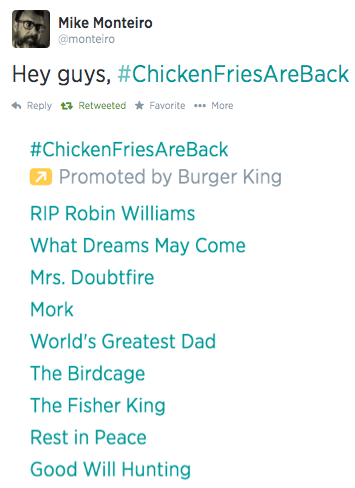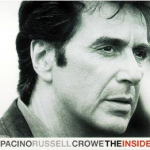Every time a notable death hits me hard, I end up thinking about Frank O’Hara’s “The Day Lady Died,” his elegy for Billie Holliday.
Thinking about it today, after Robin Williams’s death, makes it seem a very strange poem, and a kind of amazing contrast to the way we lived with and reacted to the news about Williams.
The speaker of “The Day Lady Died” spends most of his lines limning his lunchtime errands with notable checking of names and brands, a lot of them even more notable for being set in small caps. To me, this feels like an intoxicating consumer fantasy of a life in the arts in 1950s Manhattan: to spend one’s (considerable) money on lunch, books, booze, and smokes while looking forward to dinner with friends and strangers. It descends into what seems like parody as he considers buying “Hesiod, trans. Richmond Lattimore” and other things blatantly boho and blatantly phrased with pretention, like “Les Nègres / of Genet.”
I’m probably reading incorrectly or offensively how much names and brands, and the purchasing of names and brands, serve to make the speaker seem like a grotesque of the postwar cultured New Yorker, but the catalog of things he buys and considers buying make this part of the poem seem like it comes from a lifestyle magazine, from a slightly Atlanticized riff on “What Sort of Man Reads Playboy?” It feels much more like the kept life of George Peppard in Breakfast at Tiffany’s than an actual life. It is absolutely captivating.
And it is on top of this Midtown fantasy of everyday boho life that the inescapable oppression of Holliday’s death sits. When the speaker finally acknowledges the subject of the poem, finally breaks the tension the reader has felt waiting for the part about the dead person, It feels as if the title itself has been applying the unacknowledged weight to the lines below it. It becomes clear as the speaker “casually ask”s for cigarettes and, oh yeah, a newspaper carrying the reality and finality of what has happened, that all the purchasing and futzing about which status-signaling literature to purchase has been in the service of avoiding this moment.
Seen against the absence of Holliday’s name—even in the title, her sobriquet “Lady Day” is hidden in reversal, and in the text she is only “she” and “her”—the focus on proper nouns and brands can be seen as a welcome distraction. Consumerism is being used to avoid the ache of loss and terror of death. But the devastation of the memory of her at poem’s end suffuses everything, makes names—and the power man thinks he wields with his naming—puny.
In contrast:

Here’s a screen capture of trending topics tweeted by Mike Monteiro about an hour after the news about Williams broke wide. And it’s the polar opposite of the poem: One brand name and like a dozen references to the deceased.
Here, the presence of an unrelated corporate brand is presented and understood as a sick joke. There is no comfort in Chicken Fries, there is only the friction created by pre-programmed content trying to horn in on the discussion of the day and the recognition of its absurdity. Rather than drowning our mourning selves in consumerism, there’s a recognition that only a contextual consumerism is appropriate (my roommates right now are watching The Birdcage) and that it forms only part of our response.
The brand names that we on social media distracted ourselves with were no distraction at all—they were “Robin Williams” and the names of his works. I don’t think anyone will disagree that we all felt the magnitude of the event, and that we or people we know are as moved by the death of Williams as the poem’s speaker was by that of Holliday. But clearly we have vastly different ways of coping with loss than our poor speaker does.
O’Hara’s speaker attempts to note—in proper-noun specifics down to the proximity of the nearest holiday—the details of a day that have names attached to them and can be taken as a (fantasy) version of normality. He attempts to locate himself in this specific name-branded day to avoid engulfing, timeless loss.
On the internet, though, we brought together immediate feelings, memories of Williams and his work, and clips from throughout his career. We located—or lost—ourselves in a kind of timeless, borderless soup of recognitions of his absence and recreations of his presence. It’s hard not to think of this as the healthier of the two responses.
It’s also hard—even if we stay away from cultural criticism—not to pick up on echoes of menace and the death instinct in “The Day Lady Died” that O’Hara probably didn’t intend. His speaker is buying four hundred cigarettes for the weekend, for Christ’s sake (probably for two people, sure, but still, damn). His version of normality is already soaked in death even on days when Billie Holliday has not died.
And I am sure similar accusations can be leveled at us as we stare at screens in our coping. In that spirit, here is footage of Frank O’Hara reading “The Day Lady Died” and I want you to watch it with the knowledge in mind that (as is stated earlier in the video) this performance was filmed just weeks before O’Hara’s own death from an auto accident.
 Sharelines, the dopey white flag the LA Times waved to twitchy social media culture earlier this year, have made their way to the Tribune mothership in a recent Chicago Tribune redesign.
Sharelines, the dopey white flag the LA Times waved to twitchy social media culture earlier this year, have made their way to the Tribune mothership in a recent Chicago Tribune redesign.

 On a good day I’ll document 150 sources, which means 150 instances of hitting Command-P to bring up the print dialog, 150 times I have to move a hand to the mouse to bring up the PDF menu in that dialog, and 150 times I move it back to save.
On a good day I’ll document 150 sources, which means 150 instances of hitting Command-P to bring up the print dialog, 150 times I have to move a hand to the mouse to bring up the PDF menu in that dialog, and 150 times I move it back to save.
